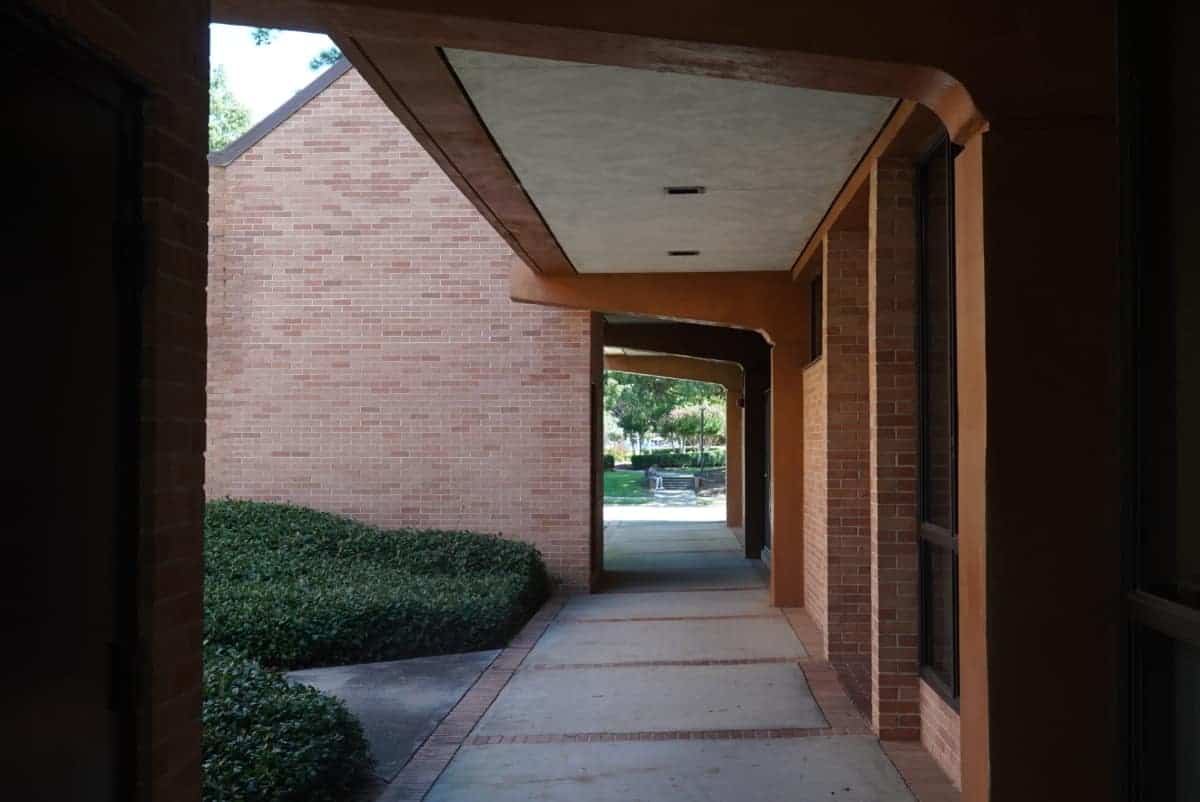“The only valid philosophy for North Carolina is the philosophy of total education; a belief in the incomparable worth of all human beings … whose talents the state needs and must develop to the fullest possible degree,” said W. Dallas Herring, the chair of the State Board of Education, in 1964, several months after the establishment of the N.C. Community College System.
“That is why,” Herring added, “the doors to the institutions in North Carolina’s system of community colleges must never be closed to anyone of suitable age who can learn what they teach.”1
To this day, Herring’s “open door” philosophy animates the work of North Carolina’s 58 community colleges. State law requires these institutions to admit all “students who are high school graduates or who are beyond the compulsory age limit of the public school system and who have left the public schools.”2 And adult students across North Carolina actively turn to community colleges to meet their educational needs. In 2016-17, some 697,000 people in all, or nine of every 100 adult North Carolinians, studied at a community college.3
Funding for North Carolina’s community colleges comes from state appropriations, local government funds, tuition receipts, and federal and other sources. State appropriations are the single largest source of funds, accounting for $57 of every $100 in fiscal year 2015-16.4 Of that state funding, nearly 90 percent is awarded to local colleges based on a funding formula.5
The state funding formula is largely based on full-time equivalent enrollment; in short, funding is based on an institutional input. While North Carolina has used a formula-based model to fund its community colleges for decades, as have many states, the formula has long suffered from shortcomings that have hindered community colleges from realizing their missions. In 2008, I wrote about these issues for the Center’s May 2008 issue of North Carolina Insight.
In recent years, the N.C. General Assembly has revised the funding formula in ways that have fixed certain flaws and have yielded a model deemed “functional and generally acceptable” by key stakeholders.6 Despite these improvements, colleges still face financial challenges. Chief among these are the stability and adequacy of state funding, the promotion of student success, the shifting of costs to students via tuition increases, and the overarching issue of equity.

The N.C. Community College System (NCCCS) traces its roots to 1963, when a set of existing junior colleges and industrial education centers were combined and placed under state authority so as to create “one system of post-high school institutions offering college parallel, technical-vocational terminal and adult education tailored to area needs.”7 Today, the state’s 58 community colleges offer programs in three broad areas.8
Curriculum programs offer credit-bearing courses that lead to the awarding of certificate, diplomas, and the associate of arts or associate of science degree; programs range from one semester to two years in length and prepare students for entry-level positions in industry or for transfer to a four-year university at the level of a junior.
Continuing education courses are non-credit bearing courses that are occupational, academic, or recreational in nature.
Basic skills instruction assists adults who are deficient in basic literacy skills or who did not complete high school with improving their skills and earning a high school equivalency credential; instruction also is available for adults seeking to learn English as a Second Language.
The defining trait of the NCCCS is its “open door” policy, under which it serves all eligible individuals who wish to study. The emphasis on universal access is further reflected in the fact that most every North Carolinian lives within 30 miles of a campus, combined with a longstanding commitment to keep tuition charges as low as possible.9 In 2016-2017, an in-state student in a curriculum program paid $76 per credit hour, which translated to $2,432 annual tuition charge (exclusive of fees and living costs) for a full-time student.10
The combination of the “open door” policy, a large geographic footprint, and low tuition has made the NCCCS a major provider of postsecondary education. In 2016-17, some 697,114 individuals, or nine of every 100 North Carolina adults, took at least one community college course.11 In general the overwhelming majority of students enroll in continuing education courses, followed by curriculum programs and basic skills instruction.12
Because many community colleges began as local educational institutions linked to local public school systems, today’s system relies on a hybrid governance structure. Local boards of trustees oversee individual colleges, while the State Board of Community Colleges and the System Office in Raleigh provide general oversight, management, planning, and coordination.13

The legislation that established the NCCCS envisioned three broad sources of financial support. The state would pay 65 percent of total costs, primarily instructional ones, while county governments would pay for 15 percent of total costs, primarily facility ones; the remaining 20 percent would come from tuition receipts.14 While the percentages have fluctuated over the years and while some other sources—federal funds in particular—are now available, the basic pattern remains in effect today, with the state playing the role of the primary funder.
In fiscal year 2015-16, the NCCCS received $1.9 billion in revenues. Of every $100 in revenue, $57 came from state appropriations, $19 from tuition receipts, $13 from local governments, and $11 from other sources.15
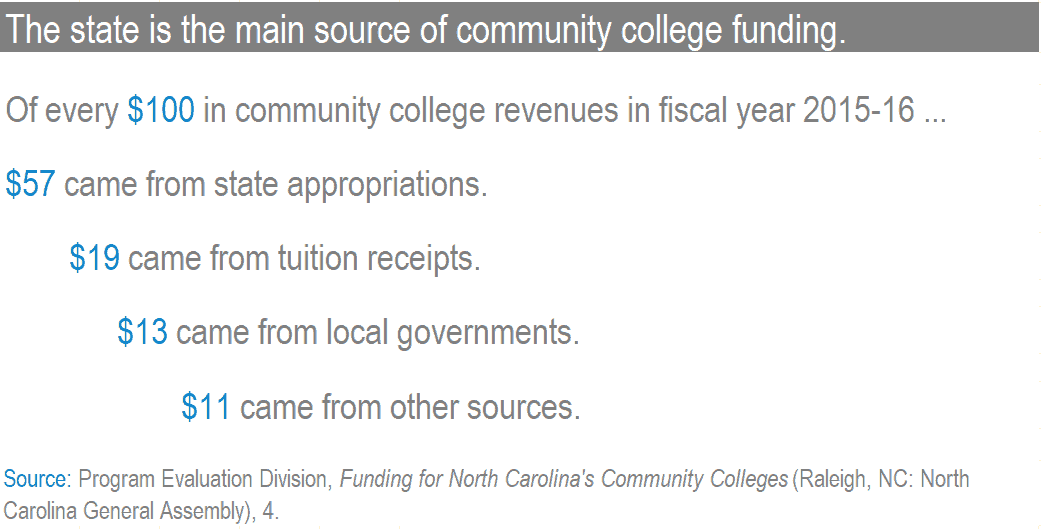
The $1.1 billion appropriated to the NCCCS from the state’s General Fund accounted for 9 percent of all appropriations on education; for perspective, consider how the public schools received $8.5 billion in appropriations (69 percent), the University of North Carolina System, $2.7 billion (22 percent).16 On a relative basis, the NCCCS received the least amount of support, and the University of North Carolina system, the most support.17
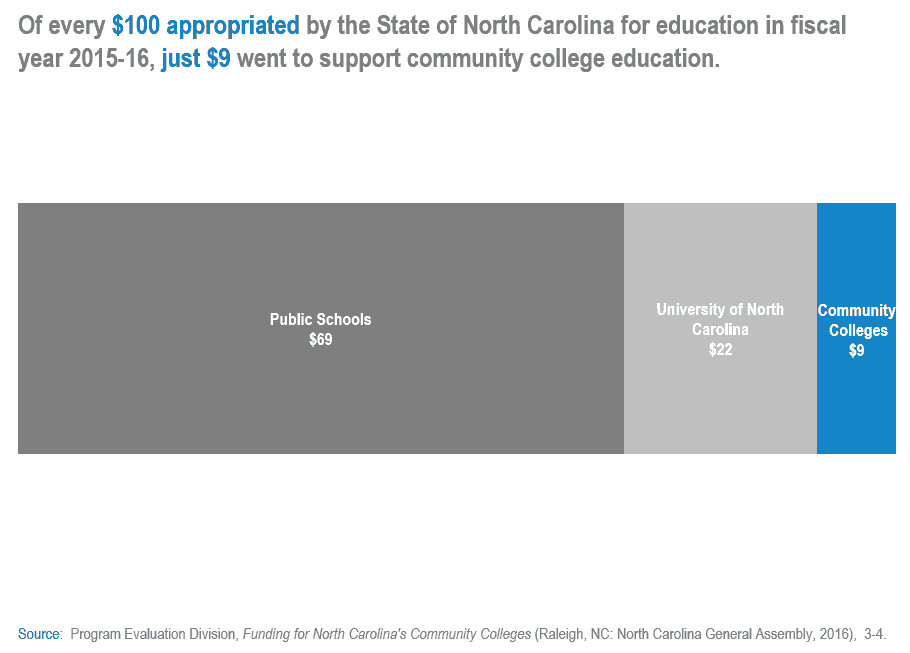
The “open door” nature of community colleges and their role in serving adult learners creates special financial challenges. When economic conditions deteriorate, community college enrollment usually rises as displaced workers seek out retraining. Yet declining tax revenues make it hard to meet the increased service demand. The typical result is a drop in funding.
According to one analysis, inflation-adjusted state support for the NCCCS fell by $939 per full-time equivalent student between 2007-08 and 2016-17; this 16 percent decline over a nine-year period reduced funding to $4,891 per full-time equivalent student from $5,830.18
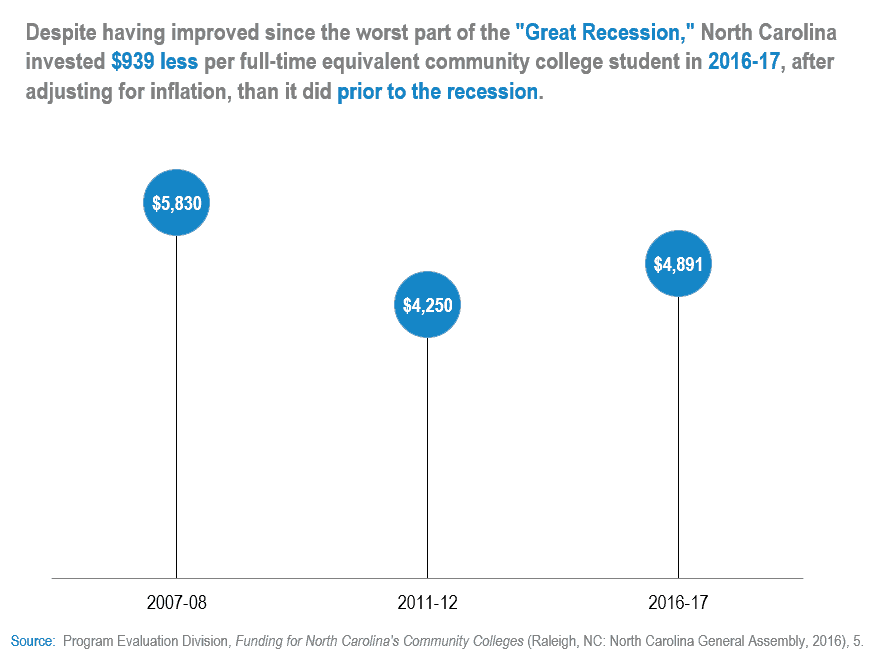
At the same time, the legislature has steadily raised tuition charges. In 2007-08, in-state students enrolled in curriculum programs paid $42 per credit hour (which equals $51 after adjusting for inflation), but by 2018, the charge per credit had risen to $76; that translates to an inflation-adjusted increase of 49 percent.19
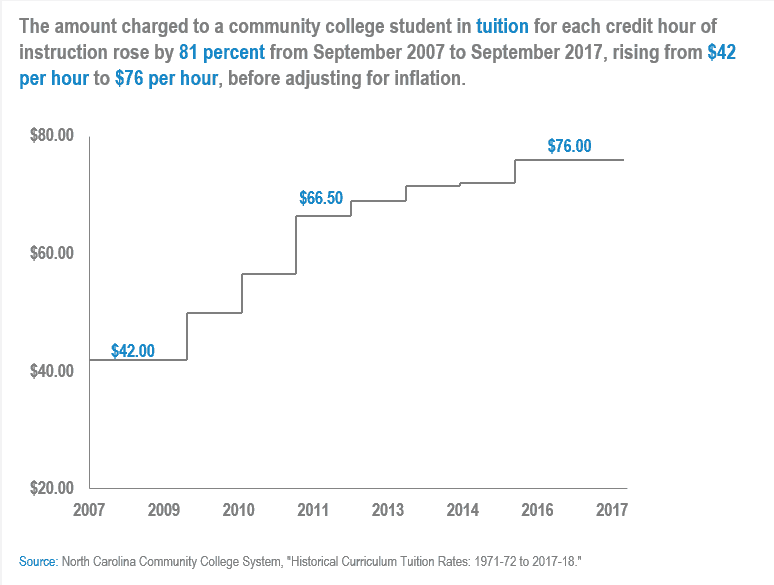
Although tuition charges in North Carolina remain low compared to those in other states, the increases are noticeable and present hardships to displaced, dislocated, or low-income adults wishing to study at a community college.

The General Assembly distributes funding to community colleges primarily on the basis of student enrollment. In fiscal year 2016-17, some 83 percent of state funding was distributed based on enrollment, with the remaining funds coming from base allotments (15 percent) and performance awards (2 percent).20 What are full-time equivalent enrollment and allotments?
The core unit used to calculate local funding in North Carolina is full-time equivalent (FTE) enrollment. For curriculum programs, a college earns one FTE for every 512 hours of class or laboratory hours scheduled in a year.21 Continuing education courses, meanwhile, generate one FTE for every 688 hours of scheduled class time.
In a given year, colleges receive budget FTE based on the higher of the FTE earned in a given year or the average of the actual FTE earned over the prior two years.22 This is done to stabilize funding against sudden budget fluctuations caused by enrollment changes stemming from factors beyond a college’s control, such as shifts in the business cycle or population changes.
Each budget FTE carries a specific allotment, or dollar value, that ranged in 2016-17 from $4,270 to $2,792.23 In general, the highest allotments are provided to curriculum courses in high-cost, high-demand fields such as health care and technical education, the lowest to short-term occupational courses that do not lead to a third-party or recognized industry credential. For a more detailed look at enrollment and FTE, read our EdExplainer.
https://www.ednc.org/2019/03/05/edexplainer-community-college-enrollment/
The evolution of the funding model, 1967-2010
North Carolina has awarded state funding to community colleges based on a formula linked to FTE enrollment since 1967.24 The original formula was a projection-based model that took a college’s enrollment from the prior fall term and added 60 percent to that total. Projection-based models remained in use until the late 1980s, when the discovery of fraudulent financial practices at Cape Fear Technical Institute (now Cape Fear Community College) led to the identification at other colleges of questionable practices designed to “pad” enrollments so as to draw more state funding. Then, in 1988, errors in the calculation of the projection model resulted in a multi-million dollar excess appropriation that the NCCCS was allowed to retain.
In response to these problems, the General Assembly shifted to a funding-in-arrears model, under which colleges receive funding based on their actual FTE enrollment in past years.25 A shortcoming of this model is that it potentially exposes colleges to sharp annual budget fluctuations. To promote stability, the General Assembly has employed different formula criteria to differing degrees of effectiveness. From 1994 to 1998, the state used a “growth and decline” rule that increased a college’s funding only if its enrollment changed by a certain percentage from a prior year. When that system proved problematic, the state moved in 1999 to a rolling average rule. Under that model, a school’s budget FTE is computed based on the higher of its actual FTE for the most recent school year or its actual FTE enrollment in a defined past period. From 1998 to 2013, state funding was based on the higher of actual FTE for the last school year or average actual FTE enrollment over the prior three years.
Recent changes to the funding model, 2011-present
North Carolina has allocated state funds to community colleges based on a funding-in-arrears model for some 30 years, although the model has undergone occasional revisions. Since 2010, the General Assembly has implemented three noteworthy changes to the funding system.
First, in 2011, the General Assembly implemented tiered funding, under which the value of an FTE varies by program type.26 All course offerings today are separated into one of four categories, with the value of an FTE earned in each category being set equal to a percentage of the value of an FTE earned in the preceding one. The idea is to provide greater funding to programs that are more expensive to operate, such as health care and technical programs, or that support industry and lead to the awarding of in-demand industry credentials.
Second, in 2013, the General Assembly changed the rolling-average rule to a two-year period from a three-year period.27 This move was controversial because it reduced system-wide state funding by $21 million dollars, or 1.8 percent. The reason for the decline was tied to enrollment decreases associated with an improving economy. Under a two-year average rule, funding drops more sharply when enrollment declines than under a three-year average rule.
Finally, the General Assembly opted in 2013 to expand and revise the use of performance-based funding.28 North Carolina first implemented performance-based funding in 1999, and under the old framework, individual colleges that achieved certain goals could retain a fractional percentage of their prior year’s state appropriation. Now, there is a fixed amount of money available to all 58 colleges based on their performance on eight measures relative to all the other colleges. Performance-based funding nevertheless remains a small part of total state funding, amounting to no more than $2 of every $100 in state appropriations.
This is Part One of our look into how North Carolina funds community colleges. Part Two will dive into the historical and current challenges presented by the funding model. To recap how the state currently funds community colleges, watch the video below.
